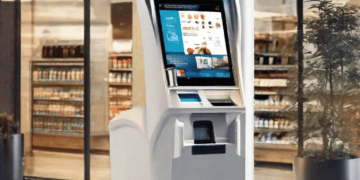The landscape of various industries has seen significant transformations due to the global pandemic, prompting a surge in the utilization of self-service kiosk technology.
The integration of kiosks into business operations is not a novel concept, especially in Canada, where these automated systems have been employed for decades to streamline transactions, enhance operational efficiency, and bolster security measures. However, the onset of the pandemic catalyzed a noticeable uptick in kiosk investments across diverse sectors. Businesses diversified their use of kiosks for functions like navigation, vending, check-ins, dispensing services, and point-of-sale transactions.
Based on the 2021 Canadian Kiosk Market Report by SCI and Signifi, industries such as healthcare and public services witnessed a substantial increase in kiosk adoption, with a reported 44% and 57% surge in investments, respectively, since 2019.
The heightened reliance on self-service technologies during the pandemic has cultivated a greater sense of ease and familiarity among both consumers and employees. There’s an emerging realization of the value kiosks bring in facilitating routine tasks such as self-checkout, interactive guidance systems, vending services, and employee check-ins.
Beyond the immediate necessity to pivot towards technology during the pandemic, businesses have discovered multiple compelling reasons to embrace kiosks. Notably, the primary drivers for investing in self-service technologies revolve around enhancing customer and employee satisfaction, identified by 63% of businesses as a top priority. Other significant factors include reducing wait times, optimizing customer flow, boosting productivity, and cutting operational costs. Users, on the other hand, appreciate the convenience, swift transactions, and improved access to information that kiosks offer.
The potential of kiosks goes beyond conventional understanding, extending to aspects like compliance and accessibility. These technologies are increasingly being leveraged to aid diverse groups, including new immigrants, seniors, and individuals with disabilities, offering language translation services, large-text options, and text-to-speech functionalities.
Moreover, organizations are exploring diverse kiosk applications that support scalable solutions and facilitate business expansion. These include secure storage solutions, equipment access management, inventory control systems, and cash management tools.
A notable shift has occurred in how businesses perceive automation. It has evolved from merely driving operational efficiency to becoming a pivotal tool in enhancing the overall customer experience. Kiosks are no longer viewed as replacements for human roles; rather, they are seen as instruments that enable humans to focus on their strengths: assisting others and solving complex issues.
While the pandemic undoubtedly accelerated the interest and investment in self-service kiosks, there are clear indications that this trend will persist and flourish. A staggering 77% of organizations assert that kiosk technology will play a crucial role in their business strategies over the next five years.
Businesses are actively adapting to this shift, incorporating kiosk technology into their digital transformation blueprints. Expectations indicate an escalation in these endeavors as revenue and activities pick up pace beyond 2021, marking a continual integration and evolution of kiosk technology within various sectors.
Stay informed with supply chain news on The Supply Chain Report. Free tools for international trade are at ADAMftd.com.
#SelfServiceKiosks #KioskTechnology #DigitalTransformation #AutomationInBusiness #CustomerExperience #PandemicDrivenChange #KioskAdoption #HealthcareKiosks #PublicServiceKiosks #VendingTechnology #SelfCheckout #InteractiveSystems #OperationalEfficiency #BusinessExpansion #AccessibilityTechnology #ComplianceTech #EmployeeSatisfaction #ProductivityBoost #OperationalCosts #TechInnovation #FutureOfBusiness #KioskInvestments #SmartTechnology #AutomationTrends

















